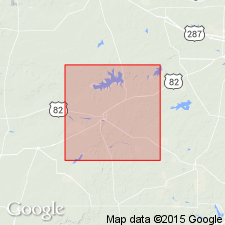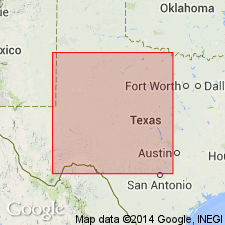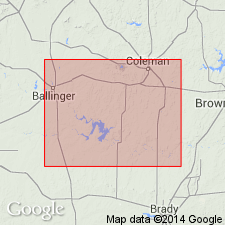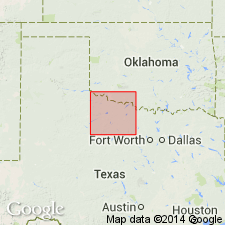
- Usage in publication:
-
- Lake Kemp limestone
- Modifications:
-
- Original reference
- Dominant lithology:
-
- Limestone
- AAPG geologic province:
-
- Bend arch
Summary:
Lake Kemp limestone lies at top of Lueders formation and 45+/- feet higher than Maybelle limestone. [The top limestone of Lueders formation in Jones and Taylor Counties was called Lueders limestone by P.A. Meyers and H.T. Morley (Texas Bur. Econ. Geol., geol. maps of Jones and Taylor Counties, 1929), but this name is preoccupied by Lueders formation. Age is Permian.]
Source: US geologic names lexicon (USGS Bull. 896, p. 1135).

- Usage in publication:
-
- Lake Kemp limestone member
- Modifications:
-
- Revised
- AAPG geologic province:
-
- Bend arch
Summary:
Pg. 169, 174. Lake Kemp limestone is top member of Lueders formation. Occurs at east end of Lake Kemp, Baylor County, central northern Texas. [Age is Permian.]
Source: US geologic names lexicon (USGS Bull. 896, p. 1135).

- Usage in publication:
-
- Lake Kemp formation
- Modifications:
-
- Revised
- AAPG geologic province:
-
- Bend arch
Summary:
Pg. 66 (fig. 1). Lake Kemp formation of Lueders group. Given formational status in the Lueders herein designated as group. Overlies Maybell limestone; underlies Arroyo formation of Clear Fork group. [Age is Early Permian (Leonard).]
Source: US geologic names lexicon (USGS Bull. 1200, p. 2083).

- Usage in publication:
-
- Lake Kemp limestone
- Modifications:
-
- Not used
- AAPG geologic province:
-
- Bend arch
Summary:
Sheet 2. Lake Kemp limestone. Examination of type outcrops of Maybelle and Lake Kemp beds affords no satisfactory ground for classing the limestones as part of the Lueders. No basis found for recognizing any limestone beds of the Lueders in Colorado River area [mapped in this report] as corresponding to Maybelle and Lake Kemp beds, respectively.
Source: US geologic names lexicon (USGS Bull. 1200, p. 2083).

- Usage in publication:
-
- Lake Kemp Limestone
- Modifications:
-
- Mapped
- AAPG geologic province:
-
- Bend arch
- Palo Duro basin
Summary:
Lake Kemp Limestone. White to gray, fine-grained, thin- and wavy-bedded, argillaceous limestone, 1 to 2 feet thick. Top bed of Lueders Formation of Albany Group (Baylor Co.) and Waggoner Ranch Formation of Wichita Group (new; Wilbarger Co.). Fossils (algae). Age is Early Permian (Leonard).
Source: Publication.
For more information, please contact Nancy Stamm, Geologic Names Committee Secretary.
Asterisk (*) indicates published by U.S. Geological Survey authors.
"No current usage" (†) implies that a name has been abandoned or has fallen into disuse. Former usage and, if known, replacement name given in parentheses ( ).
Slash (/) indicates name conflicts with nomenclatural guidelines (CSN, 1933; ACSN, 1961, 1970; NACSN, 1983, 2005, 2021). May be explained within brackets ([ ]).

